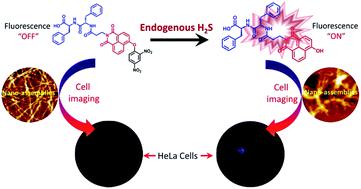当前位置:
X-MOL 学术
›
Chem. Sci.
›
论文详情
Our official English website, www.x-mol.net, welcomes your feedback! (Note: you will need to create a separate account there.)
A naphthalimide-based peptide conjugate for concurrent imaging and apoptosis induction in cancer cells by utilizing endogenous hydrogen sulfide
Chemical Science ( IF 8.4 ) Pub Date : 2021-11-17 , DOI: 10.1039/d1sc04030h Narendra Singh 1 , Swati Sharma 1 , Ramesh Singh 2 , Swati Rajput 3 , Naibedya Chattopadhyay 3 , Deepshikha Tewari 4 , Khashti Ballabh Joshi 2 , Sandeep Verma 1
Chemical Science ( IF 8.4 ) Pub Date : 2021-11-17 , DOI: 10.1039/d1sc04030h Narendra Singh 1 , Swati Sharma 1 , Ramesh Singh 2 , Swati Rajput 3 , Naibedya Chattopadhyay 3 , Deepshikha Tewari 4 , Khashti Ballabh Joshi 2 , Sandeep Verma 1
Affiliation

|
The excessive production of endogenous hydrogen sulfide (H2S) in cancer cells leads to enhanced tumor growth and metastasis. On the other hand, decreased endogenous H2S suppresses tumor growth. The reported approaches for inhibiting tumor growth are selective silencing of the tumor-promoting genes and pharmacological inhibition of these proteins. To enhance the antitumor efficacy of frontline chemotherapeutic agents, herein, we synthesized a highly sensitive endogenous H2S responsive fluorescent probe, i.e., a hydrogen sulfide-sensing naphthalimide-based peptide conjugate (HSNPc), which showed selective inhibition of proliferation of cancer cells due to apoptosis induction. Furthermore, HSNPc suppressed the glycolytic reserve, a critical energy source for the proliferation of cancer cells. HSNPc also decreased the Young's modulus of HeLa cells compared to the control cells, which demonstrated a direct relation between cell apoptosis and cell stiffness. Taken together, we demonstrated the dual function of detection and killing of cancer cells by HSNPc that can be likened to a theranostic role.
中文翻译:

基于萘酰亚胺的肽缀合物,利用内源性硫化氢同时成像和诱导癌细胞凋亡
癌细胞内源性硫化氢(H 2 S)的过量产生导致肿瘤生长和转移增强。另一方面,内源性H 2 S减少抑制肿瘤生长。已报道的抑制肿瘤生长的方法是选择性沉默促肿瘤基因和对这些蛋白质进行药理抑制。为了增强一线化疗药物的抗肿瘤功效,我们合成了一种高度敏感的内源性H 2 S响应荧光探针,即硫化氢敏感的基于萘酰亚胺的肽缀合物(HSNPc),它可以选择性地抑制癌细胞的增殖。由于细胞凋亡诱导。此外,HSNPc抑制了糖酵解储备,这是癌细胞增殖的关键能量来源。与对照细胞相比, HSNPc还降低了 HeLa 细胞的杨氏模量,这表明细胞凋亡和细胞硬度之间存在直接关系。综上所述,我们证明了HSNPc检测和杀死癌细胞的双重功能,这可以比作治疗诊断的作用。
更新日期:2021-12-01
中文翻译:

基于萘酰亚胺的肽缀合物,利用内源性硫化氢同时成像和诱导癌细胞凋亡
癌细胞内源性硫化氢(H 2 S)的过量产生导致肿瘤生长和转移增强。另一方面,内源性H 2 S减少抑制肿瘤生长。已报道的抑制肿瘤生长的方法是选择性沉默促肿瘤基因和对这些蛋白质进行药理抑制。为了增强一线化疗药物的抗肿瘤功效,我们合成了一种高度敏感的内源性H 2 S响应荧光探针,即硫化氢敏感的基于萘酰亚胺的肽缀合物(HSNPc),它可以选择性地抑制癌细胞的增殖。由于细胞凋亡诱导。此外,HSNPc抑制了糖酵解储备,这是癌细胞增殖的关键能量来源。与对照细胞相比, HSNPc还降低了 HeLa 细胞的杨氏模量,这表明细胞凋亡和细胞硬度之间存在直接关系。综上所述,我们证明了HSNPc检测和杀死癌细胞的双重功能,这可以比作治疗诊断的作用。



























 京公网安备 11010802027423号
京公网安备 11010802027423号